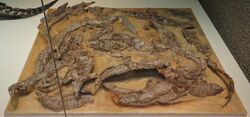Biology:Aetosaurinae
| Aetosaurinae Temporal range: Late Triassic
| |
|---|---|

| |
| A bonebed of Aetosaurus | |

| |
| Paratypothorax, a typothoracine | |
| Scientific classification | |
| Missing taxonomy template (fix): | Archosauria/Reptilia |
| Clade: | Pseudosuchia |
| Order: | †Aetosauria |
| Family: | †Stagonolepididae |
| Subfamily: | †Aetosaurinae Heckert and Lucas, 2000 |
| Clades | |
Aetosaurinae is one of the two main clades of aetosaurs, the other being Desmatosuchia. It is a stem-based taxon defined as all aetosaurs more closely related to Aetosaurus than Desmatosuchus. Aetosaurinae currently comprises Aetosaurus, similar forms such as Coahomasuchus and Stenomyti, and the widespread and successful aetosaur clade Typothoracinae.[1]
Previous usage
Aetosaurinae was originally named in 2000, as a subfamily solely including Aetosaurus, which was assumed to be the earliest-diverging aetosaur.[2] In 2007, it was extended to include the subfamily Typothoracinae as well as various basal aetosaurs which were not clearly within Desmatosuchinae. These proposed non-typothoracine aetosaurines included Coahomasuchus, Neoaetosauroides, Aetosauroides, Stagonolepis robertsoni, and "Stagonolepis" (Calyptosuchus) wellesi. As a subfamily containing practically all non-desmatosuchine aetosaurs, Aetosaurinae was poorly-supported. It was diagnosed by a singly synapomorphy: the dorsal eminence of each paramedian osteoderm was offset medially.[3][4]
A phylogenetic study in 2012 found that this widest usage of Aetosaurinae was paraphyletic. Aetosaurus was recovered as the basal-most stagonolepidid, with other non-typothoracisine aetosaurines placed as successively more derived taxa leading up to a clade containing Desmatosuchinae and Typothoracisinae. In this phylogeny, all aetosaurines except for Aetosaurus were more closely related to Desmatosuchus than they are to Aetosaurus. As a result, the clade Aetosaurinae would only include Aetosaurus.[5][6]
Current usage
More recent data and phylogenies have brought Aetosaurinae back into usage, albeit in a more restricted form. A 2016 study once again considered Typothoracinae to be closer to Aetosaurus than to desmatosuchines. Therefore, Typothoracinae would lie within Aetosaurinae, making Aetosaurinae a valid and non-monotypic clade once more.[1] Newly described or redescribed genera such as Stenomyti and Coahomasuchus have also been incorporated into Aetosaurinae.[1][7] Aetosaurinae is the sister taxon to Desmatosuchia, a new clade including desmatosuchines and their relatives, such as Stagonolepis.[1]
Relative to desmatosuchians, aetosaurines have proportionally shorter and more lightly built skulls, as well as several other distinctive traits. The orbit is large and circular, while the supratemporal fenestrae are fairly small. This also means that the parietals are wider than the frontals on the skull roof, at least in early-diverging genera such as Aetosaurus and Stenomyti. The nares are similar in size or smaller than the orbit. The snout tapers to a point, without the "shovel-shaped" premaxilla extensions found in Stagonolepis and Desmatosuchus.[1][8]
References
- ↑ 1.0 1.1 1.2 1.3 1.4 Parker, William G. (2016-01-21). "Revised phylogenetic analysis of the Aetosauria (Archosauria: Pseudosuchia); assessing the effects of incongruent morphological character sets" (in en). PeerJ 4: e1583. doi:10.7717/peerj.1583. ISSN 2167-8359. PMID 26819845.
- ↑ Heckert, A. B.; and Lucas; S. G. (2000). "Taxonomy, phylogeny, biostratigraphy, biochronology, paleobiogeography, and evolution of the Late Triassic Aetosauria (Archosauria: Crurotarsi).". Zentralblatt für Geologie und Paläontologie, Teil I 11-12: 1539–1587. https://www.academia.edu/1175956.
- ↑ Parker, W. G. (2007). "Reassessment of the aetosaur Desmatosuchus' chamaensis with a reanalysis of the phylogeny of the Aetosauria (Archosauria:Pseudosuchia)". Journal of Systematic Palaeontology '5: 41–68. doi:10.1017/S1477201906001994. http://www.miketaylor.org.uk/dino/nm/Parker2007-Heliocanthus.pdf.
- ↑ Parker, William G.; Stocker, Michelle R.; Irmis, Randall B. (2008-09-12). "A new desmatosuchine aetosaur (Archosauria: Suchia) from the Upper Triassic Tecovas Formation (Dockum Group) of Texas". Journal of Vertebrate Paleontology 28 (3): 692–701. doi:10.1671/0272-4634(2008)28[692:ANDAAS2.0.CO;2]. ISSN 0272-4634. https://www.researchgate.net/publication/272152066.
- ↑ Desojo, J.B.; Ezcurra, M.D.; Kischlat, E.E. (2012). "A new aetosaur genus (Archosauria: Pseudosuchia) from the early Late Triassic of southern Brazil". Zootaxa 3166: 1–33. doi:10.11646/zootaxa.3166.1.1. ISSN 1175-5326. https://www.researchgate.net/publication/280386026.
- ↑ Heckert, Andrew B.; Schneider, Vincent P.; Fraser, Nicholas C.; Webb, Richard A. (2015-01-02). "A new aetosaur (Archosauria, Suchia) from the Upper Triassic Pekin Formation, Deep River Basin, North Carolina, U.S.A., and its implications for early aetosaur evolution". Journal of Vertebrate Paleontology 35 (1): e881831. doi:10.1080/02724634.2014.881831. ISSN 0272-4634. Bibcode: 2015JVPal..35E1831H. https://doi.org/10.1080/02724634.2014.881831.
- ↑ Hoffman, Devin K.; Heckert, Andrew B.; Zanno, Lindsay E. (2018-02-13). "Under the armor: X-ray computed tomographic reconstruction of the internal skeleton of Coahomasuchus chathamensis (Archosauria: Aetosauria) from the Upper Triassic of North Carolina, USA, and a phylogenetic analysis of Aetosauria" (in en). PeerJ 6: e4368. doi:10.7717/peerj.4368. ISSN 2167-8359. PMID 29456892.
- ↑ Reyes, William A.; Parker, William G.; Marsh, Adam D. (2020-12-10). "Cranial anatomy and dentition of the aetosaur Typothorax coccinarum (Archosauria: Pseudosuchia) from the Upper Triassic (Revueltian–mid Norian) Chinle Formation of Arizona". Journal of Vertebrate Paleontology 40 (6): e1876080. doi:10.1080/02724634.2020.1876080. ISSN 0272-4634. Bibcode: 2020JVPal..40E6080R. https://doi.org/10.1080/02724634.2020.1876080.
Wikidata ☰ Q3495831 entry
 |

